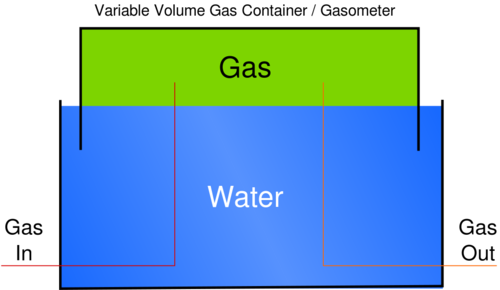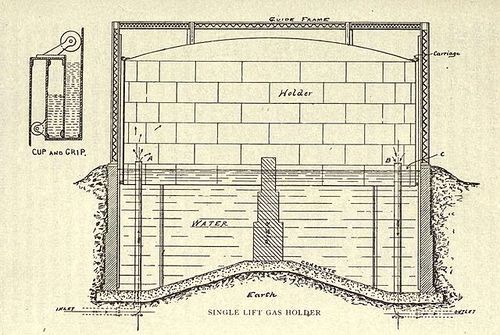Gas Holder: Difference between revisions
Jump to navigation
Jump to search

(added intro text) |
(Added some more information) |
||
| Line 2: | Line 2: | ||
[[File:640px-Page 313 Single Lift Gas Holder.JPG|500px|thumb|right|Single lift gasholder for use in storage of coal gas (1909). ]] | [[File:640px-Page 313 Single Lift Gas Holder.JPG|500px|thumb|right|Single lift gasholder for use in storage of coal gas (1909). ]] | ||
=Basics= | |||
*Also known as a gasometer | |||
*Uses a similar mechanism to holding a cup upside down in water to trap gas for storage | |||
*It acts as a buffer - removing the need for continuous gas production. | |||
*In the traditional design the weight of the gasholder lift (cap) controlled the pressure of the gas | |||
*Consists of two main parts: | |||
**a deep tank of water that was used to provide a seal | |||
**a vessel that rose above the water as the gas volume increased | |||
[[File:1024px-Gasometer.svg.png|500px|thumb|right|Gas holder with an external fixed frame. Water provides a seal. The whole tank floats in a circular water reservoir, held up by the roughly constant pressure of a varying volume of gas. The pressure is determined by the weight of the structure, and the water providing the seal for the gas within the moving walls. Besides storing the gas, the tank's design serves to establish the pressure of the gas system. ]] | [[File:1024px-Gasometer.svg.png|500px|thumb|right|Gas holder with an external fixed frame. Water provides a seal. The whole tank floats in a circular water reservoir, held up by the roughly constant pressure of a varying volume of gas. The pressure is determined by the weight of the structure, and the water providing the seal for the gas within the moving walls. Besides storing the gas, the tank's design serves to establish the pressure of the gas system. ]] | ||
=Possible Uses== | |||
* | *Low Pressure Gas Storage | ||
* | **Mainly of combustable/"difficult" gasses like [[Syngas]] , [[Methane]] , [[Biogas]], and [[Hydrogen]] | ||
*Also may potentially work for storing C02 rich exhaust for [[CO2 Enrichment]] (especially if pre-processed with a [[Gas Scrubber]] | |||
**This would also produce (dilute?) carbonic acid, for better or worse | |||
*Not the best for this application, but may act as a sort of [[Wet Scrubber]] | |||
*Slightly modified to produce an [[Ionic Liquid Piston Gas Compressor]] | |||
= | =Useful Links= | ||
*Wikipedia: [https://en.wikipedia.org/wiki/Gas_holder Gas Holder] | *Wikipedia: [https://en.wikipedia.org/wiki/Gas_holder Gas Holder] | ||
*The Telegraph: [http://www.telegraph.co.uk/finance/newsbysector/energy/oilandgas/10473071/Gasometers-a-brief-history.html "Gasometers: a brief history"] | *The Telegraph: [http://www.telegraph.co.uk/finance/newsbysector/energy/oilandgas/10473071/Gasometers-a-brief-history.html "Gasometers: a brief history"] | ||
[[Category:Energy]] | [[Category:Energy]] | ||
[[Category:Biofuel]] | [[Category:Biofuel]] | ||
Revision as of 04:33, 22 April 2020
Basics
- Also known as a gasometer
- Uses a similar mechanism to holding a cup upside down in water to trap gas for storage
- It acts as a buffer - removing the need for continuous gas production.
- In the traditional design the weight of the gasholder lift (cap) controlled the pressure of the gas
- Consists of two main parts:
- a deep tank of water that was used to provide a seal
- a vessel that rose above the water as the gas volume increased

Gas holder with an external fixed frame. Water provides a seal. The whole tank floats in a circular water reservoir, held up by the roughly constant pressure of a varying volume of gas. The pressure is determined by the weight of the structure, and the water providing the seal for the gas within the moving walls. Besides storing the gas, the tank's design serves to establish the pressure of the gas system.
Possible Uses=
- Low Pressure Gas Storage
- Also may potentially work for storing C02 rich exhaust for CO2 Enrichment (especially if pre-processed with a Gas Scrubber
- This would also produce (dilute?) carbonic acid, for better or worse
- Not the best for this application, but may act as a sort of Wet Scrubber
- Slightly modified to produce an Ionic Liquid Piston Gas Compressor
Useful Links
- Wikipedia: Gas Holder
- The Telegraph: "Gasometers: a brief history"
